
For this special feature, we invited the presidents of the region’s leading institutions of higher education to respond to the following: It’s a time of unprecedented challenge for higher education—with decliningenrollment, increased competition, concern about cost and debt, and increasinglyrapid technological change. How are you approaching your key challengesso that your institution will survive and thrive?

Allegheny College: James H. Mullen, Jr.
Higher education continues to evolvedramatically, as it has over the two centuriessince Allegheny College’s founding.We have remained true to our commitmentto educating students to becomedifference-makers in their careers andcommunities. In a competitive environment,we’re also working even harder toensure students and families know whatsets Allegheny apart, including our outstandingundergraduate research experiences,our dedication to service, and ourleadership in the national discussionabout civility in public life.
We’re investing in what students wantand need: developing innovative programsto meet market demand, enhancingbuildings and technology to better facilitatethe groundbreaking work our facultyand students do every day, and bolsteringresources to support and engage studentsfrom a wide range of backgrounds.
Finally, we’re making clear the returnon investing in an Allegheny degree.Through the Allegheny Gateway, we’reconnecting students with the tools toapply their classroom learning in studyabroad programs, internships and otherexperiences that prepare them foremployment and graduate school. Manyof these opportunities are provided byour loyal alumni base, which includesthousands in Greater Pittsburgh. This is atime of great challenge. But it is also atime of great potential at Allegheny.

California University of Pennsylvania: Geraldine M. Jones
California University of Pennsylvaniais re-engineering itself for a new generationby embracing its special mission inscience and technology, a part of Cal U’sidentity for more than 40 years.
We are building on our strength—career-focused programs that engage studentsin active and applied learning. Withan eye on the future, we are adding innovativeprograms in high-demand fields,from an associate degree in drone technologyto a tech-focused MBA in businessanalytics.
Cal U has not abandoned its historicrole in teacher education, and we believethat college graduates in every professionbenefit from a background in liberal arts.But we are homing in on programs thatblend academic excellence, innovationand applied education to create pathwaysto the STEM careers of the future.
At the same time, Cal U is prioritizingtechnology literacy for students in all subjectareas. It’s clear that our graduates willfind a wider range of career opportunitiesif they enter the workforce with STEM-focusedskills.
By re-emphasizing California’s specialmission in science and technology, we areforging a sustainable identity that willmake Cal U the preferred choice for capable,career-focused students, now and inthe years ahead.
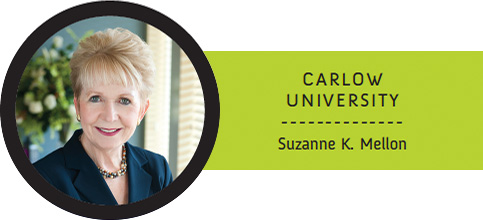
Carlow University: Suzanne K. Mellon
This time of unprecedented challengeis also one of unprecedented opportunity,especially as an innovative, Catholic universityanswering our historic and ongoingcommitment to serve our region’sneeds. As a member of the AlleghenyConference’s Workforce DevelopmentCommittee, I know how critical it is foruniversities such as Carlow to connectwith area businesses to provide the rightopportunities for degree completion andup-credentialing. As the recent InflectionPoint report noted, we need to make surestudents and employees are lifelong learners.Employees need to be able to up-skillon the job, businesses need to maketuition remission a key feature of a greatworkplace, and our universities need tooffer the learning they need as students.Carlow’s agreements with our communitycollege partners are an important part ofthis imperative. So are our new micromaster’scertificates that allow professionalsto earn credits in of-the-momentand in-demand areas of expertise, as wellas prepare for industry certification inproject management, human resourcemanagement, healthcare and fightingwhite-collar crime. And, in a year whenboth drug deaths and suicides amongemergency workers have reached recordhighs, Carlow’s programs in drug, alcoholand trauma counseling can help up-skillour region’s clinicians as well. These efficientand cost-bundled credits letemployees and employers meet eachother at the intersection of need for newskills and demand for professional development.
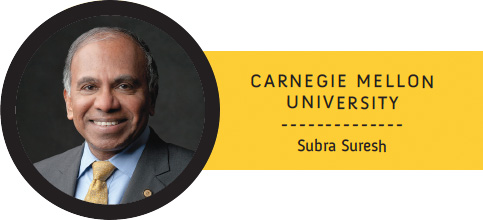
Carnegie Mellon University: Subra Suresh
At Carnegie Mellon, we are dedicatedto doing work that matters. Through acollaborative approach that involves students,faculty and staff from across disciplines,we take on some of the world’smost pressing challenges. This approachallows us to team the computer scientistwith the psychologist, the engineer withthe artist, to help ensure emerging technologiespositively impact the humancondition.
In the same spirit, we are committedto enhancing the CMU experience, helpingour students, faculty and staff tothrive. This includes major initiatives thataddress personal health and well-being,diversity, infrastructure and financial aid.
Some examples: CMU’s Board ofTrustees approved a new health and wellnesscenter, which will double the spacededicated to physical, mental and emotionalhealth, student success and communityengagement. Other projects willadd classrooms, collaborative spaces,maker spaces, and fitness and dining facilities.We are also doubling this year thenumber of students in the SummerAcademy for Math and Science (SAMS)which helps to prepare and motivate studentsfrom underserved communities forcollege education in STEM fields.
We know finances are stressful formany students and have made increasingsupport a priority. Permanent endowmentssupporting scholarships and fellowshipstotal near $500 million, includingmore than $211 million added throughour Presidential Fellowship andScholarships Program.
By enhancing the CMU experience,we hope to create a “One CMU” spiritwhich allows our students, faculty andstaff to succeed on both a personal andcommunity level.
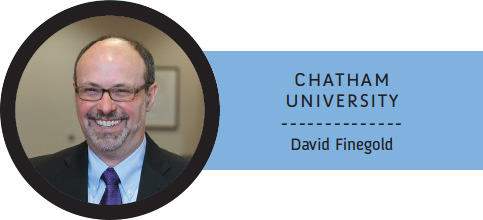
Chatham University: David Finegold
It is a time of great disruption inhigher education, but also a time ofgreat opportunity for institutions whoembrace change. At Chatham, we didthis two years ago by making the difficult,but necessary, decision to transitionour 145-year old undergraduatewomen’s college to coed. This transformationhelped us buck declining enrollmenttrends by more than doubling thesize of our incoming first-year undergraduateclasses. When paired withChatham’s unique educational offering—a beautiful liberal arts campus inthe heart of one of the nation’s greatcollege towns—our willingness tochange creates a strong foundation onwhich to build.
We continue to adapt to today’s marketplace, by growing our strong professionalmaster’s programs in highdemandareas such as health sciences,sustainability, and food studies; and creatingnew programs to meet the needsof emerging fields such as big data andhealthcare informatics. We’ve introducedthe Chatham Plan to ensureevery student gains relevant work experienceand enhances their employability.We’re also implementing multiple waysto lower costs and broaden access toChatham degrees through strong transferpathways with community colleges,dual enrollment with high schools,online and limited-residency degrees, 3-year degree options, accelerated bachelor’s-to master’s-programs, andenhanced scholarship support.
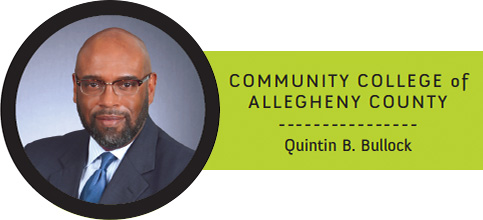
Community College of Allegheny County: Quintin B. Bullock
With a well-deserved reputation fordelivering affordable, high-quality academicand workforce technology programs,CCAC is in a unique position todeliver the type of responsive career educationand training individuals need forsuccess in today’s increasingly competitiveglobal society.
Our industry-driven, yet studentfocused,approach to education enablesCCAC to adapt to market forces resultingin job-ready skillsets beneficial to bothemployers and job applicants alike. Wecontinue to work with business andindustry leaders in high-demand fields,including our region’s many skilled tradesunions, to develop innovative programmingthat not only addresses currentneeds but also anticipates future workforceneeds and industry trends.
But our efforts don’t stop there.Through partnerships with area schooldistricts, CCAC offers students theopportunity to enroll in college coursesduring high school—providing studentswith the option of taking advanced-levelclasses while preparing them for the rigorsof a college education.
As a result of these and other initiatives,CCAC graduates have transferredto the nation’s most prestigious collegesand universities, have obtained highlycompetitive and advanced degrees andcan be found at leading companies, organizationsand institutions throughout theU.S. We are proud that our alumni areactively engaged in every sector of society,providing leadership both here inPittsburgh and around the world.
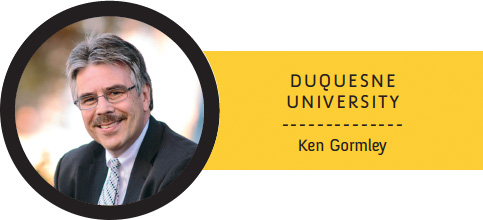
Duquesne University: Ken Gormley
A time of unprecedented challengesfor higher education is also a time ofopportunity for institutions, likeDuquesne, that have rich histories, a spiritof innovation and a desire to reinventtheir mission for a new era. Since itsfounding in 1878, Duquesne’s mission hasbeen a values-based one: Unwaveringservice to its students and the communityaround it. Duquesne’s extraordinary graduateshelped to build Pittsburgh andWestern Pennsylvania. Today, we continueto sit at the epicenter of this regionand drive positive change.
Duquesne has a beautiful campusoverlooking the city, advanced technologicalinfrastructure and fabulous undergraduate,graduate and professional academicprograms. We continue to invest inthese programs in order to create boldnew opportunities.
As the only Catholic, Spiritan universityof its kind in the world, we strive toprovide access to students from allsocioeconomic backgrounds. We continuallyrank as a “Best Value School,” becausewe work hard to provide a top qualityeducation at a low net cost. Two of myown children have attended Duquesne;they wouldn’t trade that experience foranything.
The most successful universitiesthrive because they put the interests oftheir students first and live their missionevery day. That’s why, even in times ofnew challenges, Duquesne’s star is on therise.

Edinboro University: H. Fred Walker
Edinboro University has worked fornearly a year to proactively and collaborativelyaddress the challenges facing highereducation nationwide. From my arrival inJuly 2016 through late March, all constituenciesof the university engaged inanalysis of the university’s current statusand are now at work to develop andimplement transformative action focusedon three key objectives: enhancing studentsuccess, balancing finances andrefreshing our academic program array.
Already we have raised admissionstandards, launched a data-driven reviewof academic programs, and announcedfour areas of distinction that will be ourguide for future program development:arts and digital entertainment; business,applied science and professional programming;education; and social and mentalhealth services. These four areas representlongtime strengths of the university.The academic areas of distinction buildon the success in related professions ofcountless EU alumni and provide strongcareer opportunities for current andfuture students in alignment with theworkforce Gap Analysis report commissionedby Pennsylvania’s State System ofHigher Education.
Edinboro University’s strengths andcollective resolve are far greater thanhigher education’s current challenges. Weembrace this opportunity to develop asuccessful path forward as a privilege ofour moment in history.
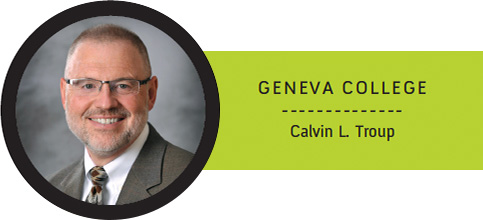
Geneva College: Calvin L. Troup
In difficult circumstances for institutions,a good first step is to consider thefoundation of institutional life.
1. Purpose & Mission: Geneva Collegewas founded to provide students with aChristian education from a biblical perspectivein the liberal arts and variousother professional and pre-professionalprograms. Our mission is to equip studentsfor faithful and fruitful Service toGod and neighbor. We believe the purposeand mission are as necessary today asthey ever have been.
2. History: We look to history ratherthan headlines. History tells us that forhigher education the questions of enrollment,competition cost and technologyare old news. While these are real challenges,they are perennial and familiarquestions for educational leaders. Theyare just in new forms. We’ve learned that institutions are resilient—in many casesmore resilient than other enterprises andventures. Therefore, we don’t need to bereactionary. We can take care, and neednot lose our nerve in the face of challenges.
3. Leadership & Strategy: History alsoteaches us that educational institutionsare highly adaptable to changing circumstancesand needs of society. Institutionsthrive when the people leading thembuild new things that continue to faithfullyaddress the basic purpose and missionof the institution. And from that foundation,develop new strategies and tactics toenhance enrollments, sharpen schoolidentity, and make education accessible tostudents who need the institution, andrespond rather than react to the everchangingconditions in human societies.
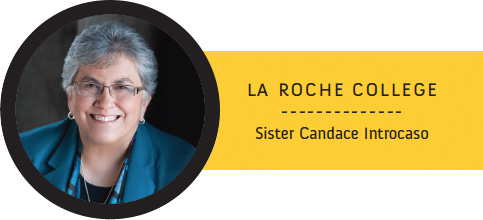
La Roche College: Sister Candace Introcaso
La Roche College was founded in1963, and like most colleges and universities,has faced challenges throughoutits history. There are two ways in whichI lead the college through challengingperiods: by letting our mission influencedecision-making, and by planningahead.
I often remind our campus communityof the college’s mission, the purposefor which we were founded and forwhich we continue to serve our students.We want our students to be lifelonglearners and global citizens. Wewant them to receive a sound educationalexperience that will guide theirprofessional and personal lives. I believethe stronger the sense of missionamong our faculty and staff, thestronger our response will be to challengesthat threaten our survival.
Preparation and adaptability also arevital to our success. Clearly the unexpectedcan (and usually does) happen,but if we build a culture of planning andif we are flexible, we are better positionedto respond to the challenges ofthe day.
To survive and thrive in today’s highereducation climate, we must remaintrue to our mission, while exploringnew and creative ways to carry out thatmission.

Point Park University: Paul Hennigan
As educators, while we’re invested inhelping students enjoy a rich social, culturaland academic experience, we’realways keeping our eye on the ball; that is,what can we do to help ensure that whenstudents land their first job, they succeed.They succeed because they understandwhat’s expected. We sometimes hearfrom the corporate community thatrecent graduates are not ready to hit theground running when they come to workand that they don’t understand the focus,discipline and just day-to-day responsibilitynecessary for a 40-hour work week.That kind of understanding requiresmany things but perhaps the most importantare good time management skills. Itsounds simple enough but as a university,we needed to find a way to betterimmerse our students in a real-worldwork experience. To do that, we launcheda cooperative education program, or coopas it’s better known. Students workfull-time and earn college credit towardtheir degree while gaining invaluableinsight into what’s needed to not only getand keep a job, but to excel and grow at it.It takes a certain kind of student to makethis experience everything it can be, onewhere they may find out what they love todo and work with others who feel thesame. It’s that student who will not onlythrive but pave the way for others.

Robert Morris University: Christopher Howard
To paraphrase the late Chuck Noll,the problems facing higher education aregreat and they are many. First and foremostin Pennsylvania is that we competefor a shrinking number of students. Ibelieve there are four ways to buck thistrend:
1. Focus on retention: We have a moralobligation to ensure our students graduateon time. And, whereas it costs businessesmore to acquire a new customerthan retaining one, the same holds truefor students.
2. Follow the Netflix model: Netflix usescustomer data to predict their behavior.Universities have no shortage of dataabout student behavior we can use toensure they “arrive and thrive” on campus.
3. Corporate partnerships: We need toexpand our enrollment portfolio in orderto include certificate and “badging” programscustomized for employers whowant to develop their workforce.
4. Embrace Pittsburgh: Pittsburgh isattracting investments from SiliconValley giants and has rejuvenated energyand manufacturing sectors. But it faces alooming workforce shortage for somejobs that require degrees and some thatdo not. Robert Morris University is inthe business of developing human capitaland can provide the professionals thisregion needs.
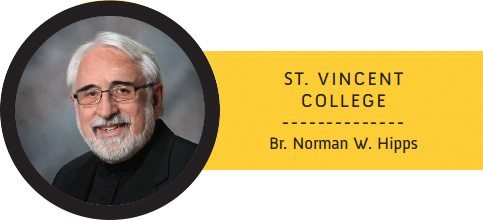
St. Vincent College: Br. Norman W. Hipps
When our founder, ArchabbotBoniface Wimmer, was faced with apoor harvest and a severe winter, hewrote to his friends in Germany,“Forward, always forward, everywhereforward. We cannot be held back bydebts, by the difficulties of the times,by unfortunate years. Man’s adversityis God’s opportunity.”
Likewise today, Saint Vincentfaces the challenges of the times withconfidence and conviction that thereis both a need in our culture for whatwe offer, and value in a Benedictine,liberal arts and sciences educationthat meets that need.
With assistance from many whobelieve in our mission, we will continueto enhance our campus with an engineeringand biomedical sciences hall,now under construction, and plans tocreate a technology and informationhub.
We will continue to add academicprograms such as criminology, cybersecurityand engineering, partnered withour classical liberal arts curriculum, toserve the changing needs of our nationand our world; to strategically offerfinancial aid to keep the Collegeaffordable; and to work with an accomplishedfaculty and lean administrationto ensure continued success not onlyfor the College, but especially for ourgraduates.

Seton Hill University: Mary C. Finger
The higher education landscape isevolving and institutions must respondto important questions about the valueof a college degree. A Seton HillUniversity degree provides the value ofa liberal arts education coupled withprofessional degree programs that preparestudents for graduate school orcareers. Through Seton Hill’s newOffice of Academic Innovation andPlanning, our faculty members aredeveloping new academic programsthat meet the needs of regional employersand address rapid changes in thetechnology, healthcare and business sectorsas outlined in the AlleghenyConference on CommunityDevelopment’s recent report“Inflection Point.” Seton Hill recentlyintroduced new majors in health scienceand cybersecurity, certificates indata analytics and software app developmentand new online MBA and adultdegree programs that allow students tofind their place in a changing workforce.Seton Hill’s nationally recognizedFit for the World career readiness programintegrates career planning in theclassroom and through experientiallearning, ensuring that students aregaining real-world experience throughinternships, research or study abroadopportunities. Seton Hill does all thisthrough the lens of the liberal arts bypreparing students to work collaboratively,think critically and creatively, andcommunicate skillfully to ensure theyare ready to lead.
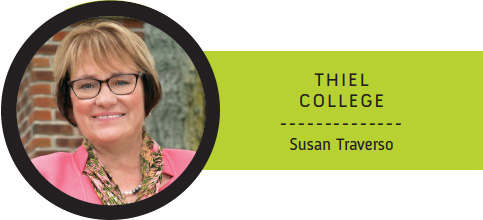
Thiel College: Susan Traverso
As Thiel College concludes the celebrationof its 150th year, it has a plan for itsfuture. The Thiel 2021: Student Successstrategic plan was approved in early 2017.In my first year, I worked with faculty, staff,students and alumni to create a plan thatincludes programming that engages first-yearstudents and the College’s minoritystudent population, ensuring that ever-greaternumbers of students graduate fromthe College prepared for lives of meaningand purpose. Inclusion and diversity areimportant at Thiel College. According tothe National Center for EducationStatistics, the College has the largest ratioof minority students among similarly-sizedinstitutions in the region. Thiel College hasbeen coeducational since its founding in1866.
Thiel 2021: Student Success focuses onthree strategic goals. These goals are creatingan inclusive learning environment,enrolling 1,100 students from a wide-rangeof backgrounds, motivated to succeed incollege, and increasing and strengtheningresources through effective leadership, faculty,and staff development, financial management,fundraising, and partnerships.
Strategic initiatives are not the onlydevelopments on the horizon. A new $4.5million science facility will be dedicated inOctober and a new track and field complexwill be completed this summer.
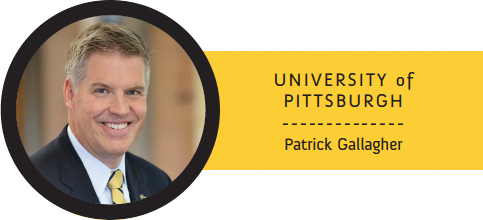
University of Pittsburgh: Patrick Gallagher
A major challenge for many universitiesis the rising cost of providing aworld-class education. At the Universityof Pittsburgh, one way that we answerthis challenge is by ensuring that our studentsreceive the greatest value andreturn on their tuition investment. Wedo this by connecting our students totop-ranked programs, first-rate facultymembers and cutting-edge res earchopportunities. We also offer a rich arrayof ways to learn outside the classroomand support students in graduating ontime or even accelerating their time to adegree.
Our commitment to cultivating ahigh-value education is working. One ofthe greatest measures of our success isour alumni, who are now spearheadingself-driving car technologies, breakingdown handwashing barriers in Third-World counties, and fighting on thef rontlines to solve complex issues such ascancer, inequity and addiction.
The best news is that these examplesof success aren’t outliers. Within sixmonths of receiving a bachelor’s degree,94 percent of Pitt graduates surveyed areemployed or working on their nextdegree. Our University’s dedication topreserving this value—no matter whatthe challenges—is one way that we standapart from other leaders in higher educationtoday.

Washington & Jefferson College: Tori Haring Smith
Washington & Jefferson College isone of the oldest colleges in the UnitedStates for a reason; we have a long historyof innovating through trying times. Inkeeping with that, we are activelyaddressing the many issues facing highereducation today.
Our motto is Juncta Juvant meaning“Together We Thrive.” Knowing that colleges’fates are tied to their communities,we are investing in the region through initiativeslike a business incubator.Additionally, we helped create thePennsylvania Consortium for the LiberalArts to collaborate with other schools onthe challenges facing our industry.
We also recognize that, to be a part ofa group solution, you have to providevalue as an individual. We continuallyenhance our curriculum to address life’srapid evolution while supporting an inclusivecommunity. One of our innovativeprograms, the Magellan Project, allowsstudents of all socio-economic backgroundsto pursue self-designed researchprojects. Subsequently, our post-collegeplacement rate is high and we have arobust network of alumni. We recentlycompleted a successful comprehensivecampaign, helping offset rising costs.
I’m confident Washington & JeffersonCollege will maintain our history ofproactively facing the future throughinnovation and partnerships. In otherwords, we will continue to thrive, together,no matter the challenge.

Waynesburg University: Douglas G. Lee
At a time when prospective studentsand their parents are asking if the costof a college education is worth it, atWaynesburg University, we can confidentlyassure them that it is.
Critical to our success is the clearsense of mission and identity that permeatesthe organization at all levels.Also critical has been the developmentof a team of extremely talented individualscommitted to our mission, with thevision, passion and ability to lead theinstitution as a selfless team, makingdecisions based on what is in the bestinterest of the institution, its studentsand employees. With the right group ofpeople working together to addresstoday’s challenges head-on, we continueto advance as the climate of higher educationevolves.
We also work hard to maintain ourvalue and keep our costs low. With 98percent of 2015 graduates reportingworking or studying within their chosenfield, the value of a Waynesburg educationis clear. Our tuition, room andboard is more than $11,500 below thenational average for private, non-profit,four-year colleges, and we are committedto remaining affordable so that aWaynesburg University education isavailable to students for generations tocome.
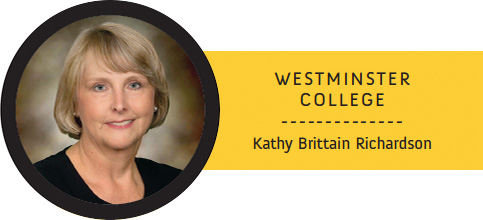
Westminster College: Kathy Brittain Richardson
Westminster College has prepared foreconomic and enrollment challenges byremaining true to its liberal arts mission,and through careful fiscal and programmaticplanning. Our analyses indicatedthat the addition of a B.S.N. nursing programin partnership with the UPMCJamesonSchool of Nursing would benefitthe college and its community, particularlyby bringing a rural focus to thestudy of nursing. We also realized capacityfor adding sports management, marketing,materials science, physics engineering,child and family studies, and digitaljournalism. Our four-year HonorsProgram was refocused to include aninternational study component and toprovide greater integration of the liberalarts curriculum across the HonorsScholars’ education. With high impactpractices like a signature capstone, experientialand service learning, undergraduateresearch, and interdisciplinary courses,all students learn and apply skills thatare important to graduate schools andemployers. In addition to academic programs,men’s and women’s lacrosse teamswere formed, offering additional opportunitiesfor students to engage in highlycompetitive Division III athletics.Renovation and expansion of the college’sscience center, its residence halls,and athletic facilities are also under way.These commitments are working.Undergraduate enrollment has grown thepast two years, with entering classes largerthan predicted.
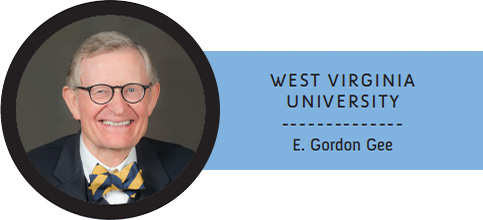
West Virginia University: E. Gordon Gee
As a land-grant institution, WestVirginia University is a powerful catalystfor changing lives. For our region,the pathway to success is an educatedcitizenry. Consider this statistic fromthe Center on Education and theWorkforce at Georgetown University:Since 2008, 11.8 million jobs haveemerged in this country. But only80,000 of those jobs required only ahigh-school education. The restrequired either a college degree or substantialpost-secondary training.
In this environment, we must moveswiftly and urgently to meet thedemands of a fast-changing society.And we must stand up and proclaim thevalue of the arts, the humanities, thesciences and education itself as forcesfor increasing human understandingand solving humanity’s challenges.
To meet 21st century needs forleadership, our faculty members arenurturing our students’ questioningspirits—and helping them to understandthat they have not only the freedomto speak, but also the responsibilityto listen and understand. In education,research, and outreach,Mountaineers are digging deeper, venturingfurther and going beyond whatis expected.
West Virginia University will thrivein the future as it has for 150 years—byadvancing education, healthcare andprosperity for all and by leading transformationin our region and aroundthe world.
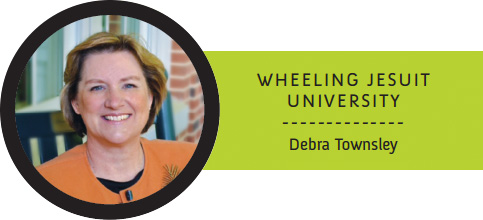
Wheeling Jesuit University: Debra Townsley
Wheeling Jesuit University adapts tothese challenging times by focusing onremaining attractive to incoming studentswhile providing a rigorous educationthat prepares young men andyoung women for lives of leadershipand service in their chosen fields.
For example, our new core curriculumgives students more choice andflexibility while ensuring time for serviceand reflection, which are hallmarksof our Catholic identity. Additionally,we are hiring a new Director of CareerServices, who, along with career preparationand internship programming, willwork with students to create portfoliosto use in future job interviews. Finally,we are developing exciting new academicofferings to produce graduates thatare necessary to our region’s workforce.
WJU remains committed to a qualityeducation at a reasonable cost.Unlike many other institutions, tuitionand fees will not be increased next year.By focusing on both quality and value,we at Wheeling Jesuit University showour commitment to our mission of life,leadership and service as a Catholic,Jesuit University in the Pittsburgh tristatearea. This focus results in over 90percent of our graduates working injobs in their major or attending graduateschool within one year of graduating—a fact we’re very proud of!




